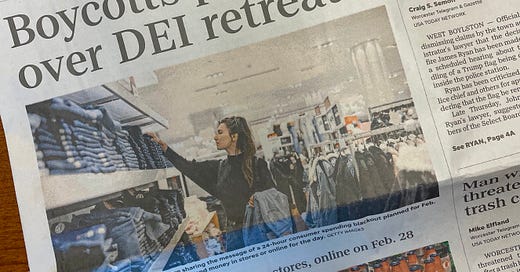Economic boycotts have long been a powerful and successful protest strategy in America. And tomorrow, many are flexing this muscle with an “economic blackout”—a day of no-spending, particularly at large corporations and gas stations.
The goal of this, and boycotts in general, is to use the economic power of the masses to gain attention and shift policy. In a capitalist society, particularly one where major corporations can directly donate to politicians, your purse is power. As MLK Jr. wrote, “The political power structure listens to the economic power structure.”1
Friday’s boycott may be successful—if for nothing else, media attention is a key component of protest—but it will also be fleeting. After all, the Montgomery Bus Boycott took 13 months, the Birmingham Campaign lasted five weeks, and the South African anti-apartheid boycott took decades.
While some high-profile, long-term boycotts are already underway for places like Target (in response to their anti-DEI policy) and Amazon (in response to Trump-ally Jeff Bezos, working conditions, etc.), figuring out which corporations and business owners align with your own personal can be overwhelming.
For those who want to align their spending with their political views, this post is for you. And it is a refresh of one of my earliest posts, and one of my favorite data sources: campaign finance data.
While I definitely recommend checking out the original post for an overview of campaign finance processes, vocabulary, and an overview of industry trends via OpenSecrets, today I’m just going to focus on Federal Election Commission (FEC) data.
FEC data
The FEC is a government website that houses all of the required information for campaign filings, and it’s really helpful to look up individual donors. Want to know who your neighbor is donating too? Or the CEO of your grocery store? Hollywood celebrity?Head to FEC.gov.
Start on the home page. Click the tab “Campaign Finance Data” and select “Look up contributions by specific individuals”:
It takes you to the below page. The names on the right list campaign donations in chronological order (the names at the top are “earmarked” contributions—similar to church pledges). As you can see, without filters, there are over hundreds of million of results.
To look up certain people, use the filter options to the left. Here, you can type in names, employers, zip codes, etc. You can also change the time period—these results show the 2020 cycle, but you can go back in time as well.
While you can search by recipient (candidate) name, we’re going to look up donors. You will need to look up the CEO/ individual’s name, rather than the corporation. As an example, let’s see what Jeff Bezos is up to. I typed in “Jeffrey Bezos” to the “Contributor Details” search bar. The results show donations by someone named Jeffrey Bezos.
Given what we know about Bezos, the CEO of Amazon, I think it’s safe to assume that three of these four entries belong to him. The fourth, a small Act Blue donation from Vermont, is likely someone else who just has the same name.
As outlined in my earlier post, there are limits to how much individuals can donate to candidates—no matter how rich they are. Thus, we can see that Jeff Bezos has donated the maximum amount ($5,000) to various PACs. Now, we can use what we know about OpenSecrets to then see who these PACs donate too:
The reverse-search shows us that this PAC donates to both Republicans and Democrats at the time. This is very common for businesses and CEOs—to contribute to Republicans and Democrats in an effort to curry favor with both parties.
But what if we want to look up someone… normal? A neighbor or small business owner? FEC.gov can do that, too. Use employer information and state to help you find the person you’re looking for.
And of course, there are other outlets for the mega rich that FEC data alone won’t capture—million dollar donations to inauguration funds, public stances, and company policymaking or working conditions—but for the day-to-day decisions like, “where should I take my car to get serviced” or “which grocery store should I use”, campaign donations are a super accessible resource.
ActBlue and WinRed
A quick note: you will see a lot of entries for “ActBlue” or “WinRed.” These are fundraising platforms for candidates and organizations. Instead of creating their own platform for donations (a heavy software lift), it’s easier for candidates and smaller organizations to utilize the existing website.
To see where the money actually goes, click the arrow next to the donation. The information is expanded to see the candidate the donation went to (“earmarked for”).
Using FEC data to guide your own spending
Figuring out where to spend your money is a powerful, but personal choice. Campaign finance data can show us who the economic elite donate too, which can help guide our own economic decisions.
Economic boycotts have a history of working, particularly in the U.S., and particularly in the face of authoritative, anti-civil rights governments. But it will likely take more than one day of no-spend behavior—rather, a long-term shift in where, and how, we spend our money.
Quoted by Kevin Young, here: https://theconversation.com/black-economic-boycotts-of-the-civil-rights-era-still-offer-lessons-on-how-to-achieve-a-just-society-228057







